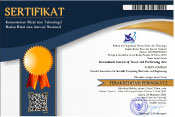*corresponding author
AbstractThis research plan intends to study, analyze, and explain comprehensively but in a more practical format regarding the interpretation and working of kendhang on the structure lampah tiga. Gendhing with the lampah tiga structure is one of the special gendhing structures because it has a bar where not many gendhing repertoires have this bar, so, of course, there are many problems for the composer, especially the ricikan kendang to present this gendhing structure, knowledge is needed to determine the interpretation and garap variant so that it can identify and present gendhing with structure. The method used is a descriptive analysis based on empirical knowledge. Empirical knowledge will help in analyzing the variety and interpretation of the lampah tiga structure, while the garap approach is used as a tool to dissect the musical situation in the intended gendhing structure. The qualitative descriptive data analysis method is carried out by observing the validity of the data through data triangulation. Accurate data collection through library research, interviews, and observations is expected to be able to explore the work on kendhangan gendhing lampah tiga. It is hoped that this research will be able to support teaching and learning activities in the form of textbooks, and it is hoped that it can add references to karawitan knowledge books.
KeywordsGarap; Kendhang; Lampah tiga; Pamijen
|
DOIhttps://doi.org/10.31763/viperarts.v5i1.825 |
Article metrics10.31763/viperarts.v5i1.825 Abstract views : 1213 | PDF views : 465 |
Cite |
Full Text Download Download
|
References
[1] Martopangrawit, Pengetahuan Karawitan I. Surakarta: Dewan Mahasiswa Akademi Seni Karawitan Indonesia, 1969.
[2] E. Schubert, “Involuntary, Limited, and Contiguously Repeating Musical Imagery (InLaCReMI): Reconciling Theory and Data on the Musical Material Acquired by Earworms,†Music Sci., vol. 6, p. 205920432311656, Jan. 2023, doi: 10.1177/20592043231165661.
[3] A. S. Aji, “Konsep Mandheg dalam Karawitan Gaya Surakarta,†Resital J. Seni Pertunjuk., vol. 20, no. 2, pp. 81–95, Aug. 2019, doi: 10.24821/resital.v20i2.3219.
[4] A. Animawan and K. Koentjoro, “Ngemong Raos: Aesthetic Leadership Role of Panjak Juru Kendhang in Javanese Gamelan,†Malaysian J. Music, vol. 10, no. 2, pp. 1–12, 2021.
[5] J. Becker and A. H. Feinstein, Karawitan: Source Readings in Javanese Gamelan and Vocal Music, Volume 1. University of Michigan Press, 2020. doi: 10.3998/mpub.17577
[6] B. S. Atmojo, “Kendhangan Pamijen Gending Gaya Yogyakarta,†Resital J. Seni Pertunjuk., vol. 11, no. 1, pp. 45–58, Nov. 2013, doi: 10.24821/resital.v11i1.495.
[7] Rahayu Supanggah, Bothekan Karawitan II. Surakarta: ISI Press, 2009.
[8] R. A. Sutton, “Creative process and colonial legacy: issues in the history and aesthetics of langendriya, Javanese dance opera,†RIMA Rev. Indones. Malaysian Aff., vol. 31, no. 1, pp. 79–122, 1997.
[9] W. T. Pambayun and N. B. Aji, “Garap Genderan Dalam Gending Lampah Tiga,†Keteg J. Pengetahuan, Pemikir. dan Kaji. Tentang Bunyi, vol. 20, no. 2, pp. 120–130, May 2021, doi: 10.33153/keteg.v20i2.3569.
[10] R. Supanggah, Bothekan Karawitan II: Garap. Surakarta: ISI Press, 2007.
[11] Waridi, “Garap dalam Karawitan Tradisi: Konsep dan Realitas Praktik,†STSI Surakarta, Surakarta, 2000.
[12] J. L. Witzleben, “Whose Ethnomusicology? Western Ethnomusicology and the Study of Asian Music,†Ethnomusicology, vol. 41, no. 2, pp. 220–242, Jan. 1997, doi: 10.2307/852604.
[13] N. Ishida, “The textures of Central Javanese gamelan music: Pre-notation and its discontents,†Bijdr. tot taal-, land- en Volkenkd. / J. Humanit. Soc. Sci. Southeast Asia, vol. 164, no. 4, pp. 475–499, 2008, doi: 10.1163/22134379-90003652.
[14] R. L. Jackson, D. K. Drummond, and S. Camara, “What Is Qualitative Research?,†Qual. Res. Reports Commun., vol. 8, no. 1, pp. 21–28, Oct. 2007, doi: 10.1080/17459430701617879.
[15] O. Gelo, D. Braakmann, and G. Benetka, “Quantitative and Qualitative Research: Beyond the Debate,†Integr. Psychol. Behav. Sci., vol. 42, no. 3, pp. 266–290, Sep. 2008, doi: 10.1007/s12124-008-9078-3.
[16] D. H. Grossoehme, “Overview of Qualitative Research,†J. Health Care Chaplain., vol. 20, no. 3, pp. 109–122, Jul. 2014, doi: 10.1080/08854726.2014.925660.
[17] B. T. Khoa, B. P. Hung, and M. H. Brahmi, “Qualitative research in social sciences: data collection, data analysis and report writing,†Int. J. Public Sect. Perform. Manag., vol. 12, no. 1/2, pp. 187–209, 2023, doi: 10.1504/IJPSPM.2023.132247.
[18] S. D. deMarrais, K. B., & Lapan, “Qualitative interview studies: Learning through experience,†in Foundations for research, K. B. deMarrais and S. D. Lapan, Eds. Routledge, 2003, pp. 67–84. doi: 10.4324/9781410609373
[19] A. Irvine, P. Drew, and R. Sainsbury, “‘Am I not answering your questions properly?’ Clarification, adequacy and responsiveness in semi-structured telephone and face-to-face interviews,†Qual. Res., vol. 13, no. 1, pp. 87–106, Feb. 2013, doi: 10.1177/1468794112439086.
[20] Martopangrawit, Dibuang sayang: lagu dan cakepan gerongan gending gending gaya Surakarta. Surakarta: Seti-Aji bekerja sama dengan Akademi Seni Karawitan Indonesia, 1988.
[21] A. Sugiarto, Kumpulan Gendhing Jawa Karya Ki Narto Sabdo. 1998.
Refbacks
- There are currently no refbacks.
Copyright (c) 2023 Ananto Sabdo Aji

This work is licensed under a Creative Commons Attribution-ShareAlike 4.0 International License.
___________________________________________________________
International Journal of Visual and Performing Arts
ISSN 2684-9259
Published by Association for Scientific Computing Electronics and Engineering (ASCEE)
W: http://pubs2.ascee.org/index.php/viperarts
E: sularso@ascee.org
Organized by:
 This work is licensed under a Creative Commons Attribution-ShareAlike 4.0
This work is licensed under a Creative Commons Attribution-ShareAlike 4.0
























